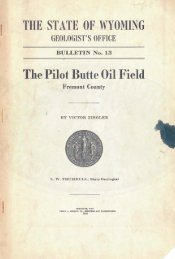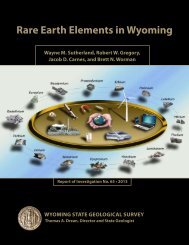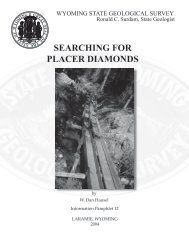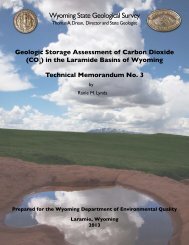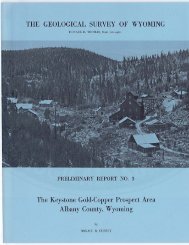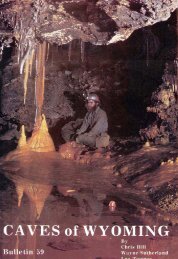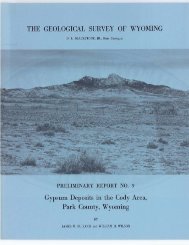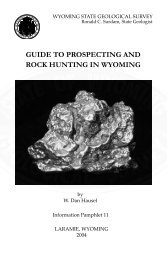The Dinosaurs of Wyoming - Wyoming State Geological Survey ...
The Dinosaurs of Wyoming - Wyoming State Geological Survey ...
The Dinosaurs of Wyoming - Wyoming State Geological Survey ...
You also want an ePaper? Increase the reach of your titles
YUMPU automatically turns print PDFs into web optimized ePapers that Google loves.
CHAPTER XX<br />
<strong>Wyoming</strong> <strong>Dinosaurs</strong> Abroad<br />
It will be the purpose <strong>of</strong> this section to deal with the preservation<br />
and exhibition in museums abroad <strong>of</strong> dinosaur bones<br />
and skeletons which had their origin from the geological deposits<br />
<strong>of</strong> <strong>Wyoming</strong>. So that the <strong>Wyoming</strong>ite, naturally a<br />
booster for his native state and its products, may seek out in<br />
his foreign travels those specimens from <strong>Wyoming</strong>, and point<br />
with pride, followed by the remark: "Why, there's old Diplodocus.<br />
He and I are from the same state !"<br />
<strong>The</strong>re are three ways for foreign museums to secure <strong>Wyoming</strong><br />
<strong>Dinosaurs</strong>, and there are many <strong>of</strong> <strong>Wyoming</strong>'s ancient<br />
reptiles in distant collections. <strong>The</strong> first way is by purchase,<br />
either from amateur collectors or from pr<strong>of</strong>essional fossil<br />
hunters. Of the latter type the fossil hunters, Charles Sternberg<br />
and his sons, have been most successful. A second<br />
method is to secure the specimens through exchange with the<br />
American museums, who have duplicate dinosaur material.<br />
<strong>The</strong> third method is through gift.<br />
Some years ago the Carnegie Museum at Pittsburgh secured<br />
exceptionally complete skeletal material <strong>of</strong> the slender,<br />
elongate, whip-tail, sauropod dinosaur which Hatcher named<br />
Diplodocus carnegiei. <strong>The</strong> animal was 80 feet long, and was<br />
taken from the Upper Jurassic rocks <strong>of</strong> <strong>Wyoming</strong>. Director<br />
W. J. Holland suggested to Andrew Carnegie, founder <strong>of</strong> the<br />
Museum, the making <strong>of</strong> plaster casts <strong>of</strong> this exceptional dinosaur,<br />
for presentation to certain foreign Museums-a truly<br />
princely gift. <strong>The</strong> plan was immediately authorized and<br />
duplicate plaster casts <strong>of</strong> this huge <strong>Wyoming</strong>ite were presented<br />
to the Kings <strong>of</strong> England and Italy, the Presidents <strong>of</strong><br />
France and Argentine Republic, and the Emperors <strong>of</strong> Germany,<br />
Austria and Russia. <strong>The</strong> gifts were accepted and these<br />
huge dinosaurians were mounted in the exhibition halls <strong>of</strong> the<br />
National Museums <strong>of</strong> these countries. This was done prio"<br />
to 1914. <strong>The</strong> last one was mounted in Buenos Aires, ArgelItina,<br />
in 1912.<br />
Prior to 1911 Mr. Carl Hagenbeck, in his zoological garden<br />
at Stellingen, had had constructed life-size restorations, in<br />
concrete, <strong>of</strong> several <strong>of</strong> <strong>Wyoming</strong>'s hugest dinosaurs, in connection<br />
with his large collection <strong>of</strong> exotic birds and mammals.<br />
113




